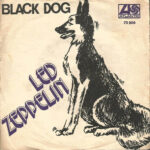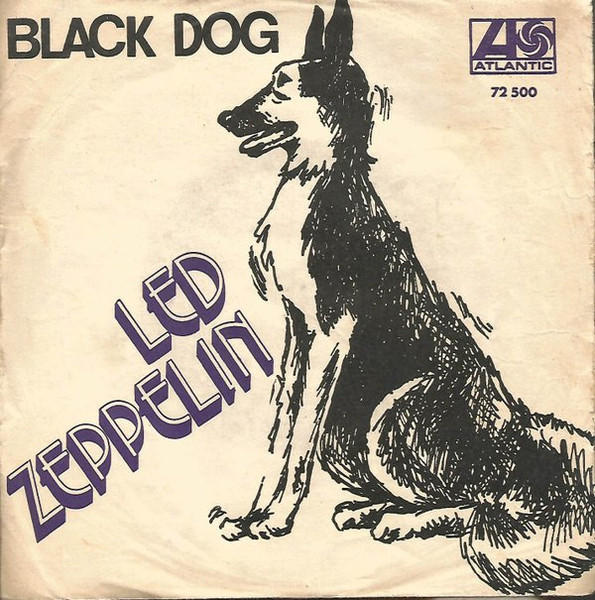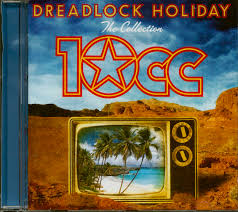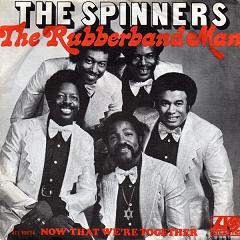 Led Zeppelin’s “Black Dog,” released in 1971 on their untitled fourth album—often referred to as Led Zeppelin IV—stands as one of the most iconic and enduring songs in rock history. Opening with one of the most instantly recognizable riffs in the annals of music, the track encapsulates the band’s ability to merge heavy blues influence, progressive rock complexity, and raw, magnetic energy. From its intricate, stop-start riff to Robert Plant’s commanding vocal performance, John Paul Jones’ melodic bass, John Bonham’s thunderous drumming, and Jimmy Page’s masterful guitar work, “Black Dog” is a masterclass in rock composition and execution. Its layered arrangements, complex rhythmic interplay, and lyrical ambiguity have ensured that it remains not only a fan favorite but also a benchmark for musicianship, creativity, and rock sensibility.
Led Zeppelin’s “Black Dog,” released in 1971 on their untitled fourth album—often referred to as Led Zeppelin IV—stands as one of the most iconic and enduring songs in rock history. Opening with one of the most instantly recognizable riffs in the annals of music, the track encapsulates the band’s ability to merge heavy blues influence, progressive rock complexity, and raw, magnetic energy. From its intricate, stop-start riff to Robert Plant’s commanding vocal performance, John Paul Jones’ melodic bass, John Bonham’s thunderous drumming, and Jimmy Page’s masterful guitar work, “Black Dog” is a masterclass in rock composition and execution. Its layered arrangements, complex rhythmic interplay, and lyrical ambiguity have ensured that it remains not only a fan favorite but also a benchmark for musicianship, creativity, and rock sensibility.
The opening of “Black Dog” is immediately arresting. A bass-driven call-and-response between the guitar and Plant’s vocals introduces a rhythmically complex and deceptively simple-sounding motif. The track begins with a series of unaccompanied guitar riffs that seem to stumble and lurch forward, creating an unsettling tension that immediately commands attention. This signature riff, written by Jimmy Page, is notable for its irregular meter and syncopation; it challenges conventional rock rhythm while remaining irresistibly catchy. Listeners are drawn into the song not through straightforward melodic or harmonic development but through a rhythmic and dynamic complexity that is both compelling and innovative. This opening establishes the tone for a song that is muscular, unpredictable, and intensely engaging, a hallmark of Led Zeppelin’s creative peak.
Robert Plant’s vocal performance on “Black Dog” is nothing short of legendary. Plant’s delivery combines blues-inspired intensity with rock theatrics, creating a sound that is simultaneously raw, powerful, and melodically rich. From the first shouted line, Plant demonstrates his uncanny ability to convey both menace and seduction, pairing lyrical ambiguity with vocal dynamics that fluctuate from whisper-like phrasing to piercing wails. His use of call-and-response with the guitar riff adds an interactive, almost conversational dimension to the song, making the vocals an integral part of the instrumental architecture rather than a separate element layered on top. Plant’s voice drives the narrative energy of the song, turning simple blues-infused phrases into an expansive emotional journey that complements the technical sophistication of the band’s instrumentation.
Lyrically, “Black Dog” is famously cryptic. Robert Plant has stated in interviews that the song was named after a black Labrador that wandered around the Headley Grange recording studio during rehearsals, though the lyrics themselves have little to do with the dog. Instead, the song explores themes of desire, pursuit, and the challenges of romantic entanglement, conveyed through Plant’s suggestive, elliptical phrasing. Lines such as “Hey, hey, mama, said the way you move, gonna make you sweat, gonna make you groove” evoke a sense of urgency and physicality, emphasizing the interplay between attraction and tension. The lyrics are delivered with both confidence and ambiguity, allowing listeners to project their own interpretations while remaining engaged by the rhythm and vocal energy. This balance between lyrical openness and musical precision is emblematic of Led Zeppelin’s approach to songwriting, where narrative and instrumental creativity coexist in dynamic tension.
John Paul Jones’ bass work in “Black Dog” exemplifies his signature combination of melodic inventiveness and rhythmic foundation. Rather than merely anchoring the harmony, Jones’ bass often acts as a counterpoint to Page’s guitar riffs and Bonham’s drums, weaving melodic threads that enhance the complexity and depth of the track. His playing is precise yet fluid, supporting the stop-start rhythm of the guitar while adding harmonic richness that propels the song forward. This interaction between bass and guitar creates a layered, polyrhythmic texture that rewards attentive listening, highlighting the sophistication underlying the seemingly straightforward blues-rock framework. Jones’ contribution underscores the collaborative brilliance of the band, where each member’s technical skill and creative intuition combine to create a cohesive yet multifaceted sound.
John Bonham’s drumming on “Black Dog” is a defining element of the track’s energy and power. Bonham’s style is simultaneously precise and explosive, capable of navigating the song’s irregular rhythmic structures while delivering thunderous impact. His ability to seamlessly transition between groove, fill, and accent adds a dynamic dimension that drives the song’s tension and release. The drumming emphasizes the push-and-pull of the stop-start riff, accentuating the tension inherent in the song’s rhythm while maintaining an irresistible momentum. Bonham’s performance demonstrates both technical mastery and a profound understanding of how percussion interacts with melody and harmony, creating a rhythmic architecture that elevates the track to a level of intensity and sophistication rare in rock music.
Jimmy Page’s guitar work in “Black Dog” exemplifies his virtuosity and innovative approach to rock guitar. The song’s riff, with its irregular meter and syncopated phrasing, is both memorable and challenging, serving as the song’s central motif. Page’s use of tonal variation, dynamic shifts, and expressive bends imbues the riff with personality and tension, while his solo sections showcase his ability to combine technical skill with emotive expression. The interplay between Page’s guitar and Plant’s vocals creates a sense of conversation, with riffs punctuating and responding to lyrical phrases, enhancing both narrative and musical depth. Page’s production choices, including layered guitar tracks and subtle tonal textures, add dimension to the recording, creating a rich sonic landscape that remains compelling decades later.
The structure of “Black Dog” is notable for its unconventional approach. Rather than adhering to a typical verse-chorus format, the song employs a series of dynamic shifts, call-and-response sections, and instrumental interludes that create a sense of unpredictability and forward motion. The stop-start riffing, alternating vocal passages, and interweaving bass lines generate tension and release, making the listener feel as though the song is constantly evolving. This approach reflects Led Zeppelin’s innovative spirit, merging blues foundations with progressive tendencies to create a track that is both rooted in tradition and forward-looking. The song’s structure contributes to its lasting appeal, ensuring that each listen reveals new details and layers of complexity.
Production techniques employed on Led Zeppelin IV enhance the impact of “Black Dog.” Recorded at Island Studios and Headley Grange, the song benefits from a combination of natural room acoustics, multi-track layering, and careful mic placement. Page’s attention to tonal detail, Bonham’s drum miking, and Jones’ nuanced bass recording contribute to a sound that is both immediate and expansive. The clarity of each instrument, combined with the dynamic range captured in the recording, allows listeners to appreciate the intricacies of the performance while feeling the visceral power of the track. This production approach exemplifies Led Zeppelin’s commitment to creating recordings that are both sonically impressive and emotionally engaging.
“Black Dog” also exemplifies the band’s ability to blend genres and influences. While firmly rooted in blues, the track incorporates elements of hard rock, progressive structures, and funk-inspired rhythmic play. The stop-start riffing, call-and-response vocals, and dynamic interplay between instruments reflect the band’s awareness of rhythm and tension, drawing from a diverse palette of musical influences. This genre-blending approach contributes to the song’s timelessness, ensuring that it resonates with fans of rock, blues, and beyond, and demonstrating Led Zeppelin’s versatility and willingness to innovate.
The chorus sections of “Black Dog” amplify the song’s energy and thematic tension. Plant’s vocal delivery shifts from teasing conversational phrasing to full-throttle proclamation, matched by increased intensity in the instrumental accompaniment. The alternation between these sections and the more rhythmically complex verses creates a dynamic contrast that sustains listener engagement and highlights the song’s structural sophistication. The interplay between vocal and instrumental elements ensures that each return to the chorus feels both familiar and climactic, maintaining momentum throughout the track.
Culturally, “Black Dog” has remained relevant for decades. It is frequently cited as one of Led Zeppelin’s signature tracks and has been covered by numerous artists across genres, from hard rock and metal bands to jazz and pop performers. Its influence can be heard in the work of countless musicians who draw inspiration from its complex riffing, rhythmic sophistication, and vocal intensity. The song’s inclusion on Led Zeppelin IV, alongside classics like “Stairway to Heaven” and “Rock and Roll,” solidified the album’s status as a cornerstone of rock history and contributed to the band’s lasting legacy as pioneers of modern rock.
Live performances of “Black Dog” further underscore its impact. The band’s ability to replicate the studio’s complex rhythms and dynamic interplay in a live setting is a testament to their musicianship and cohesion. Bonham’s drumming becomes even more thunderous in concert, Page’s guitar solos take on additional improvisatory flair, and Plant’s vocals reach new heights of intensity and expression. The track’s energy often sets the tone for performances, creating a high point that energizes audiences and demonstrates the band’s unparalleled synergy. These live renditions have contributed to the song’s reputation as a definitive rock anthem, showcasing its adaptability and enduring power in both studio and concert contexts.
The lyrics of “Black Dog,” though ostensibly simple, reveal a layered exploration of desire, pursuit, and tension. Plant’s ambiguous phrasing allows the song to function on multiple levels: as a narrative of romantic entanglement, as a blues-inspired exploration of longing, and as a vehicle for musical virtuosity. The lyrics’ interaction with the instrumental framework creates a sense of drama and immediacy, reinforcing the relentless energy conveyed through the riffs, basslines, and drumming. This integration of narrative, musical complexity, and emotional intensity is a hallmark of Led Zeppelin’s songwriting approach, exemplifying their ability to create tracks that are both intellectually stimulating and viscerally thrilling.
“Black Dog” exemplifies the symbiosis of composition, performance, and production. Every element—from Page’s innovative riffing and Bonham’s rhythmic mastery to Jones’ melodic basslines and Plant’s commanding vocals—interacts in a way that enhances the others. The production preserves this interplay with clarity and dynamic range, ensuring that each listener can appreciate both individual contributions and the cohesive power of the band as a unit. This holistic approach is a key reason for the song’s enduring impact and its continued study and admiration by musicians, critics, and fans alike.
In conclusion, Led Zeppelin’s “Black Dog” is more than a classic rock song; it is a testament to the band’s creativity, technical skill, and ability to combine innovation with raw energy. Its unforgettable riff, dynamic vocal performance, and intricate interplay between instruments make it a masterclass in rock composition. The song’s lyrical ambiguity, structural sophistication, and genre-blending approach ensure that it remains compelling decades after its release. Culturally, it has influenced countless musicians, maintained relevance in popular media, and continues to thrill audiences both in studio recordings and live performances. “Black Dog” represents the very essence of Led Zeppelin’s musical genius: a relentless drive, fearless experimentation, and the creation of music that is timeless, electrifying, and profoundly influential. Its legacy as one of the most powerful and iconic rock songs in history is indisputable, securing its place as a benchmark of excellence and innovation in the pantheon of rock music.



